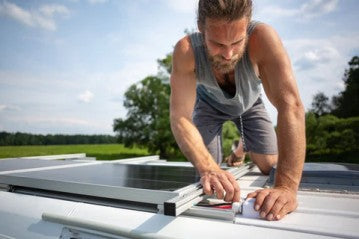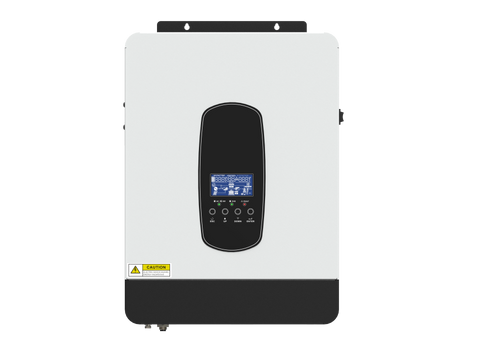
When determining the size of a solar installation, there are two key factors to take into account: wattage and voltage. As you may already be aware, solar charge controllers and inverters are assigned a rating for both wattage and voltage. For example, a charge controller could have a rating of 1440 watts and 24 volts, while inverters may be sized at 3600 watts and 24 volts. However, the question remains: how do you determine whether your system and inverter should be sized at 12, 24, or 48 volts?
Unraveling the Mystery of Watts and Volts
The enigmatic realm of watts and volts beckons our attention. Solar installations stand graded based on their energy production, harkening back to the lessons from our scholarly days where energy manifested as the offspring of power and time. Power, the fruit of voltage and current, holds the key.
To gauge a system's power output, one must acquaint oneself with its voltage and the ensuing current it begets. Picture two systems, christened System 1 and System 2, both blessed with identical output voltages. The victor in the power domain emerges as the one orchestrating greater current amidst the embrace of sunlight.
To illuminate this enigma, let's immerse ourselves in two scenarios. In the first tableau, System 1, dwelling at a lofty 100V, summons 1,000 watts, while System 2, content at 50V, summons 2,000 watts. Alas, though System 1 luxuriates in higher voltage, System 2 emerges as the potent power generator.
Such a victor translates into diminished electric bills within the realm of grid-tied solar systems. In our second setting, both System 1 and System 2 hum harmoniously at 100V, yet System 1 relinquishes 1,000 watts while System 2 luxuriates in 2,000 watts. Once more, System 2 stands as the harbinger of energy, promising a more substantial respite from the electric bill onslaught.
Ultimately, we glean that higher voltage doesn't invariably boast supremacy. In the first scenario, the elevated voltage system disappoints in the power domain, while in the second, systems sharing voltage diverge in their power outputs. Ergo, to unveil your ideal match, cast a discerning eye upon power output and your personal energy cravings.
Determining the Optimal Voltage for a Solar System
Solar systems present a choice between voltages, namely 12V, 24V, or 48V, when it comes to panels and inverters. For most recreational vehicles (RVs) and boats, 12V battery banks prevail, making 12V panels the preferred option. It is essential to verify the battery bank's voltage to ensure compatibility with the panels and the rest of the system, particularly the solar panels. Although 12V systems were once the norm for homes, today, larger home systems tend to embrace 24V or 48V ratings.
12V systems cater well to various do-it-yourself (DIY) solar scenarios, such as:
1. RVs, motorhomes, and vans
2. Camper trailers
3. Small cabins or tiny homes

RVs and motorhomes typically come equipped with 12V batteries to power lighting, hot water heater controls, AC/heating controls, and refrigerators. Hence, it is logical to align the voltage with the existing system.
If your energy needs fall within the range of 1,000 to 5,000 watts, a 24V system is a suitable choice.

For energy needs exceeding 3,000 watts, a 48V system is recommended. Large off-grid houses commonly employ 48V setups.
Can I Use a 24V Inverter with a Single 12V Battery?
One of the burning questions for many off-grid enthusiasts is whether a 24V inverter can be used with a single 12V battery. Unfortunately, the answer is no. Inverters and battery banks must have matching voltages for compatibility. Attempting to connect a 24V Pure Sine Wave All-In-One Inverter to a single 12V battery would likely result in system malfunctions and potentially damage both the inverter and the battery. Therefore, it is crucial to ensure that your inverter's voltage matches the voltage of your battery bank.
Can I Use a 12V Inverter with a 24V Battery Bank?
Similarly, using a 12V inverter with a 24V battery bank is not advisable. Mismatching the inverter and battery bank voltages can lead to inefficient power conversion, reduced performance, and potential damage to the equipment. To ensure optimal functionality and safety, always ensure that the voltage of your inverter aligns with that of your battery bank.
Is a 24V Inverter Better Than 12V?
Determining whether a 24V inverter is superior to a 12V inverter depends on your specific needs. While both options have their advantages, a 24V inverter generally offers some notable benefits. Firstly, a 24V system requires lower current compared to a 12V system for the same power output, resulting in reduced energy loss and more efficient operation. Additionally, a 24V system allows for longer cable runs, as it experiences lower voltage drop compared to a 12V system. This feature can be particularly advantageous for larger off-grid setups where distance plays a role. However, it is important to consider the compatibility of the inverter with your battery bank and overall system design before making a decision.
I'm Staying Off-Grid, Is a 12V Inverter Good for Me?
If you are planning to stay off-grid, a 12V inverter can be a suitable choice depending on your energy requirements. For smaller-scale off-grid setups, such as RVs, camper trailers, or small cabins, a 12V inverter can adequately power your essential appliances and electronics. Moreover, since many off-grid systems utilize 12V battery banks, using a 12V inverter ensures seamless compatibility with the existing setup. However, it is essential to carefully calculate your power needs and ensure that the 12V inverter can handle the required load. If your energy demands are higher or you plan to expand your off-grid system in the future, considering a higher voltage inverter, such as a 24V option, might be worth exploring.
Conclusion
Determining the ideal voltage system hinges upon your unique energy requirements. It is crucial to carefully evaluate your needs before deciding between a 12V, 24V, or 48V system. It's worth noting that a higher voltage rating, such as 48V, does not automatically equate to the best choice. Like every other aspect of a solar installation, one must consider specific requirements, existing components, and the system as a whole.
If your energy needs exceed 3,000 watts, opting for a 48V system is recommended. This higher voltage setup is better suited to handle higher power demands effectively.
For energy needs falling within the range of 1,000 to 5,000 watts, a 24V system would be appropriate. This voltage option strikes a balance between power capacity and system efficiency.
For smaller-scale projects like DIY systems for RVs, vans, or tiny homes, a 12V system is a viable choice. This lower voltage option accommodates the power requirements of such compact setups.
Ultimately, the key is to avoid falling into the misconception that a higher voltage system, such as 48V, is always the superior choice. By carefully considering your specific energy needs, the existing components of your setup, and the overall system design, you can make an informed decision that aligns with your requirements and ensures optimal performance.

 In the case of mid-range energy requirements, such as 3,000 watts, opting for a higher voltage battery bank and inverter can prove advantageous in the long run. It can potentially yield cost savings by necessitating fewer charge controllers and permitting the use of thinner cables for the same power capacity.
In the case of mid-range energy requirements, such as 3,000 watts, opting for a higher voltage battery bank and inverter can prove advantageous in the long run. It can potentially yield cost savings by necessitating fewer charge controllers and permitting the use of thinner cables for the same power capacity.
0 comments